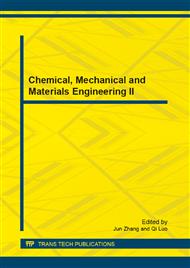[1]
L.W. Tsai: Proc. 9th Applied Mechanisms Conf., Kansas City, Missouri, Vol. 1(1985), p.1
Google Scholar
[2]
L.C. Hsieh, H.S. Yan, L.I. Wu: Journal of the Chinese Society of Mechanical Engineers Vol. 10(1989), No. 2, p.153
Google Scholar
[3]
L.C. Hsieh, H.S. Yan: International Journal of Vehicle Design, Vol. 13(5/6) (1992), p.494
Google Scholar
[4]
C. A. Nelson, R.J. Cipra: ASME Transactions, Journal of Mechanical Design Vol.127(2005), p.278
Google Scholar
[5]
M.C. Tsai, C.C. Huang: ASME Transactions, Journal of Mechanical Design Vol. 132(2010), No.065001
Google Scholar
[6]
L.C. Hsieh, H.S. Yan:Journal of CSMEVol. 14(1993), No.3, p.240
Google Scholar
[7]
L.C. Hsieh, J.Y. Liu, M.H. Hsu:Journal of CSME Vol. 20(1996), No. 4, p.421
Google Scholar
[8]
L.C. Hsieh: Journal of AMR Vol.4(1997), No.1, p.7
Google Scholar
[9]
L.C. Hsieh: Proceeding of 10th World Congress on the Theory of Machines and Mechanisms, Oulu, Finland(1999), p.2374
Google Scholar
[10]
C.H. Hsu: Journal of Mechanical Design Vol. 124(2002), No. 3. p.574
Google Scholar
[11]
W.M. Hwang, Y.L. Huang:Transactions of CSMEVol. 29(2005), No. 1, p.41
Google Scholar
[12]
L.C. Hsieh, H.S. Lee, T.H. Chen: Materials Science ForumVol. 505-507(2006), p.1003
Google Scholar
[13]
L.C. Hsieh, M.H. Hsu, T.H. Chen:Machine Design and Research Vol.22(2006), No.4, p.303
Google Scholar
[14]
L.C. Hsieh, H. S. Lee and Z.Y. Wang:International Journal of Mechanical Engineering Education Vol.36(2008), No.1, p.16
Google Scholar
[15]
Long-Chang Hsieh,Tzu-Hsia Chen: Journal of AMRVol.317-319(2011), p.2226
Google Scholar
[16]
Long-Chang Hsieh,Tzu-Hsia Chen: Journal of Advanced Science Letters Vol. 12(2012), p.34
Google Scholar
[17]
Long-Chang Hsieh,Tzu-Hsia Chen: Journal of AMRVol.591-593(2012), p.2165
Google Scholar
[18]
Long-Chang Hsieh, Hsiu-Chen Tang: Journal of AMM Vol. 232(2012), p.955
Google Scholar
[19]
C.G. Lu, Q.H. Duan: Journal of Machine Design and ResearchVol. 25(2009), No. 6, p.22
Google Scholar
[20]
A. Karaivanov, R. Popov: Proceedings of the 3rd International Conference on Manufacturing Engineering, Chalkidiki, Greece(2008), p.571
Google Scholar
[21]
A. Golenko: Journal of Archives of Civil and Mechanical EngineeringVol. 9 (2009), No. 2, p.39
Google Scholar
[22]
Takashi Takahashi, U.S. Patent04,237,750.(1980)
Google Scholar
[23]
Myung soon Bae, U.S. Patent 6,033,336.(2000)
Google Scholar
[24]
T.G. Lin Y.S. Lin, TW Patent M271989. (2004)
Google Scholar
[25]
Klinger, Raimund, Cihlar and Bernd U.S. Patent 06,500,087. (2002)
Google Scholar
[26]
Yusuke Arai, Tomoari Ouchi and Hitoshi Umezawa, U.S. Patent 07,325,780.(2008)
Google Scholar
[27]
L.C. Hsieh, Tzu-Hsia Chen, TW Patent M428280, (2012).
Google Scholar


